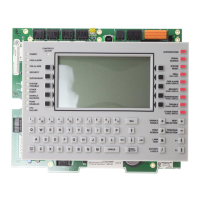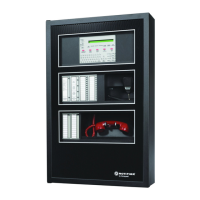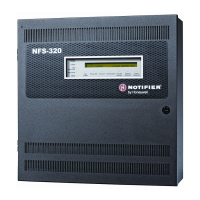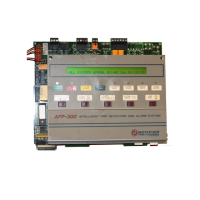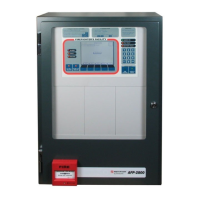NFS2-3030 Operations Manual — P/N 52546:N1 06/20//2014 29
System or Point Trouble Event Operation of the Control Panel
POINT TROUBLES
TROUBLE TYPE TROUBLE DESCRIPTION ACTION
AC FAILURE The main or auxiliary power supply has lost AC power. Determine whether there is an AC power loss or whether the
power supply and wiring is correct.
ADDRESS FAULT
†
A wireless device’s address is set to zero (0) Find and correct the wireless device’s address.
ALIGNMENT MODE A beam detector is in configuration mode. No action is necessary, as the trouble will clear when the
configuration is complete. However, the detector will not detect
a fire while this trouble exists.
AMPLIFIER LIMIT The DAL device is overloaded, Remove outputs to lower the load on the speaker circuits.
Press reset when done.
AMPLIFIER
SUPERVISION
The amplifier’s internal supervision on the DAL device is
not working,
Call Technical Services.
ANALOG OUTPUT x
TROUBLE
A trouble has occurred on the DVC-AO analog output x
(1-4). The analog output is configured for Style 7, but no
audio signal is returned.
Investigate and fix.
ASPIRATOR FAULT There is a problem with the FAAST detector. Replace the FAAST detector.
AUDIO LIBRARY
CORRUPT
The Audio Library is corrupt. The database must be re-downloaded, or all programming
must be cleared and re-entered. if the trouble does not clear,
call Technical Services.
AUDIO LIBRARY
INCOMPATIBLE
The Audio Library is not compatible with the
programming database.
Download the correct application or version.
AUTOLEARN FAILURE The Autolearn function has failed to complete. Refer to the associated detector’s product guide for additional
information.
AUXIN TROUBLE This trouble will be generated when the auxiliary input
on the DVC is supervised (as determined by VeriFire
Tools programming) and insufficient signal is detected
on the input.
Check the DVC wiring and source.
BATTERY HIGH The power supply’s battery charge is too high. Check the batteries for problems. Replace batteries if
necessary.
BATTERY LOW The power supply’s battery charge is low
OR
One or more of the four (4) batteries of a wireless
device missing or dead and the device has a minimum
of one (1) week of operation remaining.
Check the power supply batteries for problems and replace
batteries if necessary.
OR
To clear a low battery event, tamper the device and replace all
four (4) batteries. When a device is tampered, it drops out of
the mesh network and attempts to rejoin as soon as the
batteries are replaced and the tamper event is cleared. Once a
low battery trouble is indicated, there is a minimum of one (1)
week of operation before the device is non-functional.
(This trouble will latch for wireless devices until a reset is
performed on the FACP and/or FWSG)
BEAM BLOCKED Something has come between the detector’s beam and
its reflector.
Investigate and clear the blockage.
BRAND MISMATCH The brand of this SLC device is incompatible with this
FACP system.
Replace with compatible device.
BUZZER OFF The DVC’s piezo is disabled. Re-enable the piezo at switch 5.
CHARGER FAULT* The power supply’s battery charger is not working
properly.
Correct the fault.
CLASS A FAULT
†
The wireless device has a single parent connection and
is missing the redundant class A connection.
If a suitable parent is available, the background mesh
restructuring routine should self-heal the network. If the
network does not self-heal after ten minutes, reduce the
spacing between devices or utilize SWIFT Tools for suggested
repeater placement to add stronger parents. Toggle mesh
formation to trigger a mesh restructuring routine to re-evaluate
the trouble condition after taking action.
CO 6 MONTHS The CO (carbon monoxide) detection element on a
detector has six months left to expiration.
Replace the detector.
CO EXPIRED The CO (carbon monoxide) detection element on a
detector has expired.
Replace the detector.
CO TROUBLE The CO element on a detector is not working properly.
This trouble is generated for FlashScan mode only.
Replace the detector.
COMM LOSS Communication has been lost between the FMM-4-20
module and its 4-20 mA sensor.
Check connections between the FMM-4-20 module and the
4-20 mA sensor.
CONFIGURATION
FAULT
A problem has occurred after the configuration was sent
from the PipeIQ to the FAAST detector.
Re-download the configuration.
DAL DOWNLOADING The DVC is currently downloading to a DAL device. n/a
DAL DUAL ADDRESS
CONFLICT
More than one DAL device has the same address. Re-address DAL device(s).
Table 2.1 Point (Device) Troubles (1 of 4)
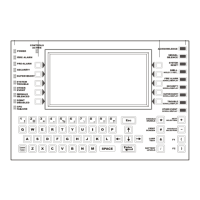
